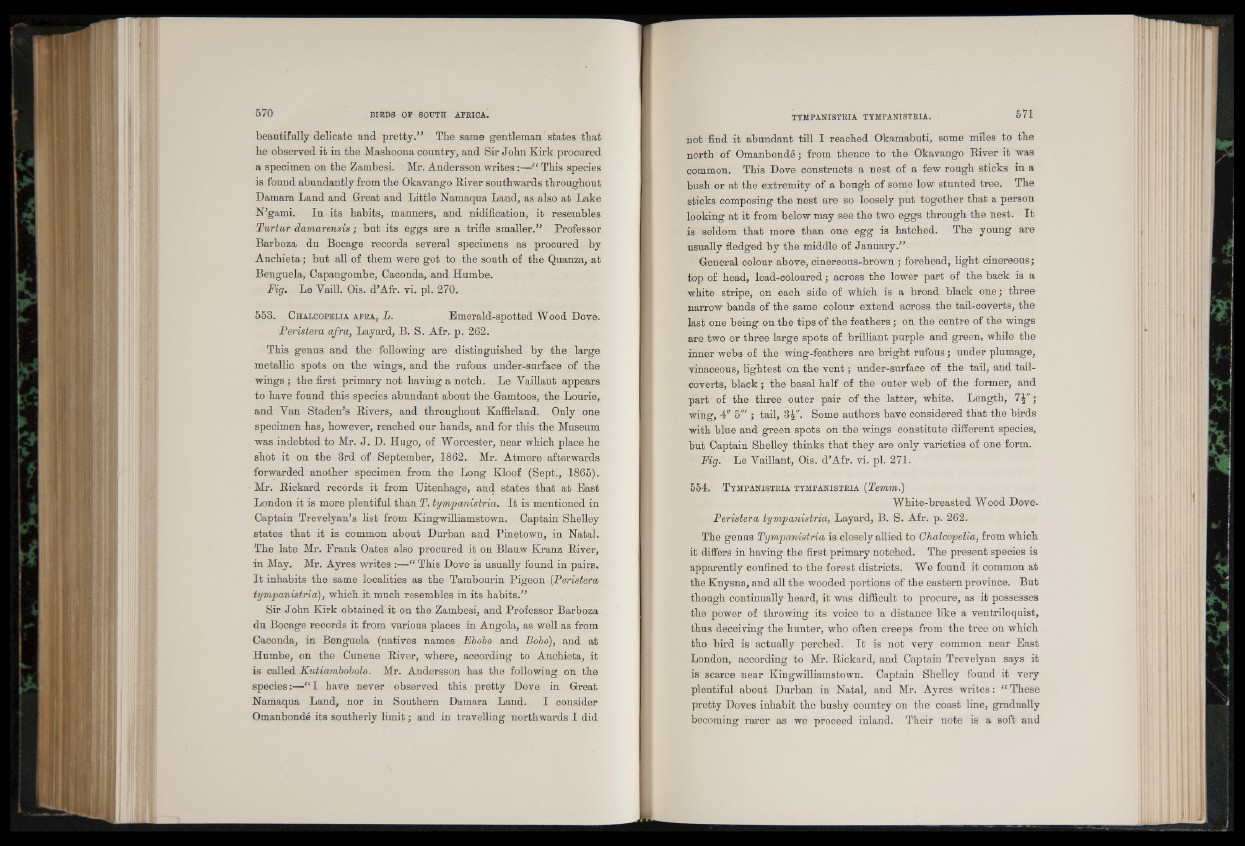
beautifully delicate and pretty.” The same gentleman states that
he observed it in the Mashoona country, and Sir John Kirk procured
a specimen on the Zambesi. Mr. Andersson writes:—“ This species
is found abundantly from the Okavango River southwards throughout
Damara Land and Great and Little Namaqua Land, as also at Lake
N’gami. In its habits, manners, and nidification, it resembles
Turtur damarensis; but its eggs are a trifle smaller.” Professor
Barboza du Bocage records several specimens as procured by
Anchieta; but all of them were got to the south of the Q.uanza, at
Benguela, Capangombe, Caconda, and Humbe.
Fig. Le Vaill. Ois. d’Afr. vi. pi. 270.
553. C h a l c o p e l ia a f r a , L. Emerald-spotted Wood Dove.
Peristera afra, Layard, B. S. Afr. p. 262.
This genus and the following are distinguished by the large
metallic spots on the wings, and the rufous under-surface of the
wings; the first primary not having a notch. Le Yaillant appears
to have found this species abundant about the Gamtoos, the Lourie,
and Van Staden’s Rivers, and throughout Kaffirland. Only one
specimen has, however, reached our hands, and for this the Museum
was indebted to Mr. J. D. Hugo, of Worcester, near which place he
shot it on the 3rd of September, 1862. Mr. Atm ore afterwards
forwarded another specimen from the Long Kloof (Septi, 1865).
Mr. Rickard records it from Uitenhage, and states that at East
London it is more plentiful than T. tympanistria. It is mentioned in
Captain Trevelyan’s list from Kingwilliamstown. Captain Shelley
states that it is common about Durban and Pinetown, in Natal.
The late Mr. Frank Oates also procured it on Blauw Kranz River,
in May. Mr. Ayres writes :—“ This Dove is usually found in pairs.
It inhabits the same localities as the Tambourin Pigeon {Peristera
tympanistria), which it much resembles in its habits.”
Sir John Kirk obtained it on the Zambesi, and Professor Barboza
du Bocage records it from various places in Angola, as well as from
Caconda, in Benguela (natives names Fibobo and Bobo), and at
Humbe, on the Cunene River, where, according to Anchieta, it
is called Kutiambobolo. Mr. Andersson has the following on the
species:—“ I have never observed this pretty Dove in Great
Namaqua Land, nor in Southern Damara Land. I consider
Omanbonde its southerly limit; and in travelling northwards I did
hot find it abundant till I reached Okamabuti, some miles to the
north of Omanbonde; from thence to the Okavango River it was
common. This Dove constructs a nest of a few rough sticks in a
bush or at the extremity of a bough of some low stunted tree. The
sticks composing the nest are so loosely put together that a person
looking at it from below may see the two eggs through the nest. It
is seldom that more than one egg is hatched. The young are
usually fledged by the middle of January.”
General colour above, cinereous-brown ; forehead, light cinereous;
top of head, lead-coloured; across the lower part of the back is a
white stripe, on each side of which is a broad black one; three
narrow bands of the same colour extend across the tail-coverts, the
last one being on the tips of the feathers; on the centre of the wings
are two or three large spots of brilliant purple and green, while the
inner webs of the wing-feathers are bright rufous; under plumage,
vinaceous, lightest on the vent; under-surface of the tail, and tail-
coverts, black; the basal half of the outer web of the former, and
part of the three outer pair of the latter, white. Length, 7£";
wing, 4" 5"'; tail, 3|". Some authors have considered that the birds
with blue and green spots on the wings constitute different species,
but Captain Shelley thinks that they are only varieties of one form.
Fig. Le Vaillant, Ois. d’Afr. vi. pi. 271.
554. T y m p a n i s t r ia t y m p a n i s t r ia (Temm.)
White-breasted Wood Dove-
Peristera tympanistria, Layard, B. S. Afr. p. 262.
The genus Tympanistria is closely allied to Chalcopelia, from which
it differs in having the first primary notched. The present species is
apparently confined to the forest districts. We found it common at
the Knysna, and all the wooded portions of the eastern province. But
though continually heard, it was difficult to procure, as it possesses
the power of throwing its voice to a distance like a ventriloquist,
thus deceiving the hunter, who often creeps from the tree on which
tho bird is actually perched. It is not very common near East
London, according to Mr. Rickard, and Captain Trevelyan says it
is scarce near Kingwilliamstown. Captain Shelley found it very
plentiful about Durban in Natal, and Mr. Ayres writes: “ These
pretty Doves inhabit the bushy country on the coast line, gradually
becoming rarer as we proceed inland. Their note is a soft and